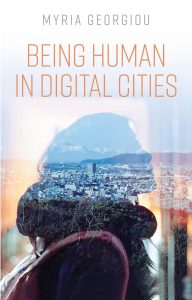In Being Human in Digital Cities, Myria Georgiou explores how technology reshapes urban life, transforming how we relate to ourselves, each other and the space around us. Examining the digital order’s influence, including datafication, surveillance and mapping, Georgiou’s essential book advocates for centring humans through the paradigm of the “right to the city” based on social justice, equity, democracy and sustainability, writes Samira Allioui.
Being Human in Digital Cities. Myria Georgiou. Polity. 2023.
 Technology, embodied through so-called smart cities (places where traditional networks and services are made more efficient with the use of digital solutions for the benefit of their inhabitants and business), has been implemented into all aspects of public and private urban life. Recently, the United Nations created the Hub for Human Rights and Digital Technology as a way to encourage cities to strategise around their “right to have digital rights,” stating that: “Together, as we seek to recover from the pandemic, we must learn to better curtail harmful use of digital technology and better unleash its power as a democratising force and an enabler”.
Technology, embodied through so-called smart cities (places where traditional networks and services are made more efficient with the use of digital solutions for the benefit of their inhabitants and business), has been implemented into all aspects of public and private urban life. Recently, the United Nations created the Hub for Human Rights and Digital Technology as a way to encourage cities to strategise around their “right to have digital rights,” stating that: “Together, as we seek to recover from the pandemic, we must learn to better curtail harmful use of digital technology and better unleash its power as a democratising force and an enabler”.
Myria Georgiou’s Being Human in Digital Cities addresses the question, how do digital cities change what it means to be human in relation to digital urbanism and digital justice? It has never been more urgent to understand how the digital order functions and its implications for controlled cities and lives. The city is where so many hopes and fears emerge for the future of humanity, and therefore studying its changing nature in a digitalised world is crucial. Moreover, the relationship between the transformation of cities and the right to the city has not yet been seriously explored.
It has never been more urgent to understand how the digital order functions and its implications for controlled cities and lives.
Intrigued by the growing symbolic power of technology in regulating the city, Georgiou demonstrates how an unstable but tenacious urban order is planned, performed, and sometimes resisted on platforms and networks to sustain the social order in cities that experience perpetual crisis. Georgiou’s principal thesis is that the digital order reflects the revived and contradictory mobilisation of humanist values across different quarters of the city. Human-centric conceptions of technology are at the heart of an emerging digital urban order. According to Georgiou, these values are gaining renewed currency by imagining and planning relationships between humans and data.
The book identifies the rhetorics and performances of the digital order as core elements of processes of change in the relational constitution of cities, technologies, and power (42). The book’s generative force comes from Georgiou’s assertion that a dynamic comeback of humanist values in and for the digital city is underway. Her central argument is that humanism matters when it mobilises (populist humanism), normalises (demotic humanism) and contests (critical humanism) power (143-144). Considering the various implications of being human in digital cities is a critical topic at a time when declarations and manifestos have emerged worldwide claiming to protect citizens’ digital rights. Digital rights are a range of protections regarding access to the internet, privacy, transparency regarding how data is used, control over how data is used and democratic participation in municipal technology decisions. They need to be protected because they represent the bridge that links our traditional human rights with the complexities of the online world, ensuring that our digital identities, decisions, and interactions are treated with the same protection and respect as in the physical world.
[Digital rights] link our traditional human rights with the complexities of the online world, ensuring that our digital identities, decisions, and interactions are treated with the same protection and respect as in the physical world.
The digital order has become a post-neoliberal response to neoliberal crises, and it breaks from the strategies of neoliberalism in different ways (31). It is a new order which “emerges because of widespread pressures to recognize the sacredness of life and the value of society” (30). Through “the promotion of unpredictability, openness and diversity, the digital order integrates instability into stability” (31). The author subtly explains why she privileges the category of the human and consequently rehumanisation-dehumanisation in understanding the digital order. Since technology is more and more infiltrating our consciousness, we become addicted to our devices that distract us and feed us information. But paradoxically, while these changes drive us to retreat to corners of comfort, we try to conquer divisiveness by cultivating communities. A research journey across eight cities of the global North and South – from London to Seoul, and from Los Angeles to Athens – over seven years has shaped Georgiou’s understanding of the digital order. From this grounding, she explains how she adopts a decentred conception of the city which privileges a transnational and transurban vision and practice. Georgiou’s methodological choice of a critical humanist approach promotes an open, creative, and participant-led approach that includes the perspectives of humans.
Georgiou adopts a decentred conception of the city which privileges a transnational and transurban vision and practice.
Her compelling research reveals two paradoxes. First, migrants’ experiences, gathered through interviews conducted with 60 teens in Athens and Los Angeles, present rehumanisation-dehumanisation as a continuum rather than a blunt proposition. Second, the Global South is ever present in cities of the Global North (113). Georgiou’s findings suggest that becoming urban reinforces autonomy. For example, migrants’ everyday experiences, mediated and linked through urban migration and technology, reveal their acute awareness that the development of autonomy protects them from certain kinds of dehumanisation such as exclusion Moreover, during this research conducted in the context of a European project on young people’s digital lives, Georgiou witnessed sentiments of enthusiasm and relief when participants were talking about a commonly used urban technology: Google Maps, including Google Earth and Street View (115). Participants were relieved because “becoming urban is not only about learning but also about being an autonomous subject in navigating city”.
Her work evidences the value of everyday technologies (namely, smartphones and apps) and the concept of “secret city” (117) for those excluded from so many other spaces of representation. A secret city only exists in a sociotechnical imagination. As a place of consumption, it is imaginary in the sense that it remains discovered and consumed through technical devices. In fact, as smart cities begin to become dehumanised realms and behavioural data is neglected, the place of humans risks being devalued. Georgiou’s research is an invaluable attempt to claim and interrogate human experiences in their entanglement with the digital in urban settings.
Georgiou describes predictive policing, the practice of using algorithms to analyse massive amounts of information to predict and help prevent potential crimes as a mundane form of symbolic violence regularly applied in the city (126). This is part of a wider trend of states’ increasing the surveillance of citizens, with surveillance understood as any personal data acquisition for management influence or entitlement. Predictive policing systems have been empirically shown to create feedback loops, where police are frequently sent back to the same neighbourhoods, regardless of the true crime rate. In the US, predictive policing tends to disproportionately target more African Americans, areas with higher concentrations of Latinos and Black, Asian and Minority ethnic (BAME) people.
In response to these trends of profiling and surveillance, the right to the city emerges as a new paradigm that provides an alternative framework with which to rethink cities and human settlements based on the principles of social justice, equity, democracy and sustainability.
In response to these trends of profiling and surveillance, the right to the city emerges as a new paradigm that provides an alternative framework with which to rethink cities and human settlements based on the principles of social justice, equity, democracy and sustainability. According to Georgiou, it presents “a revamped moral vision which points to potentially democratising processes that recognize and address urban injustices” (97). It is worth noting that Georgiou, unlike other authors, prefers to address the concept of the right to the city rather than the “right to a smart city”, her research does not advocate an approach focused on “smart citizens”, “smart citizenship” and “smart cities”. She avoids a citizen-centred approach and instead privileges life, freedom, and wellbeing, expanding her framework to include all humans in urban settings, whether they are citizens or migrants.
Finally, the book, brimming with secondary research, opens new critical avenues into techno-political research on digital cities. More precisely, knowing that humans are less studies as agents involved in the creation of digital, the book sheds light on urban humanity which often remains an opaque category. It highlights humans as agents of change and the displacement of questions of power but also of rights to the city. She investigates essential questions about what it means to be human in digital cities, suggesting that “the most compelling claims to humanism come from those who experience dehumanisation”. Such offerings beg the question of readers, who is and isn’t seen as fully human within city spaces and how does the dawn of the digital city affect those boundaries?
Note: This review gives the views of the author, and not the position of the LSE Review of Books blog, or of the London School of Economics and Political Science.
Image credit: Goldilock Project on Shutterstock.







